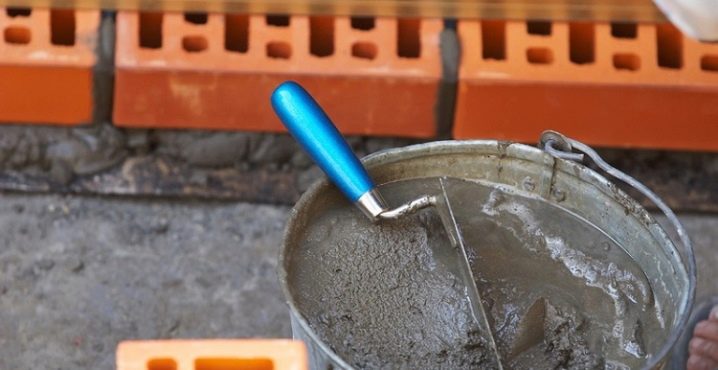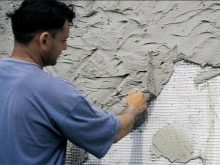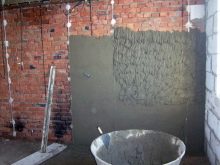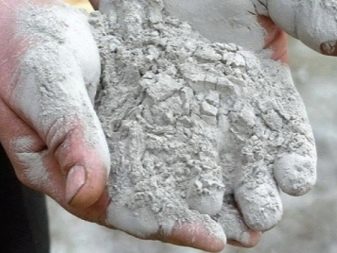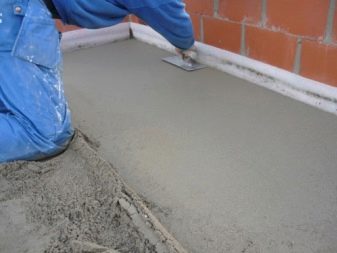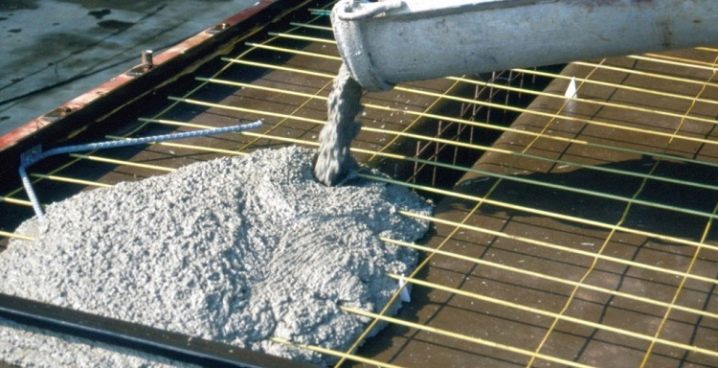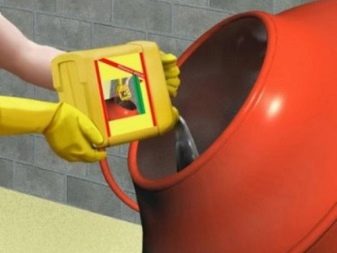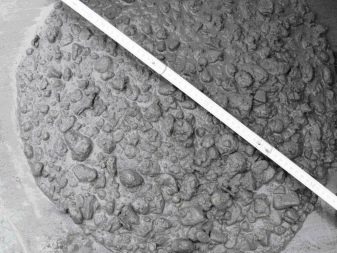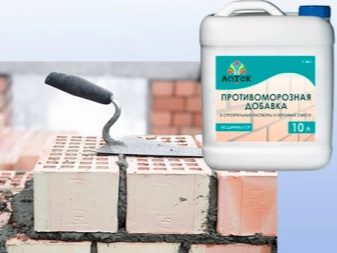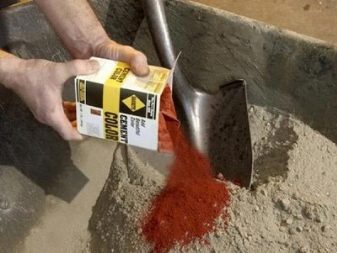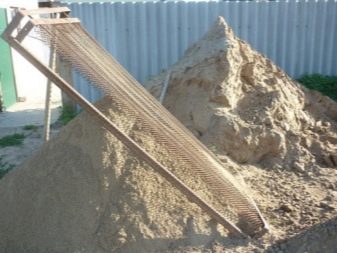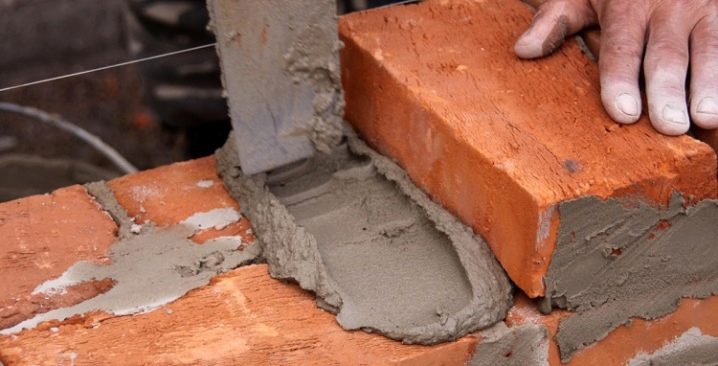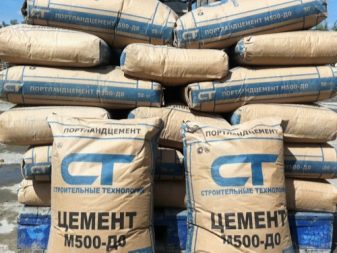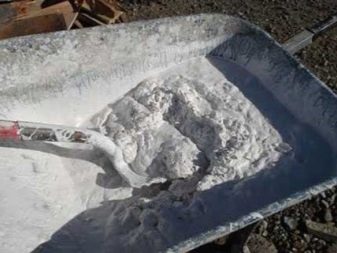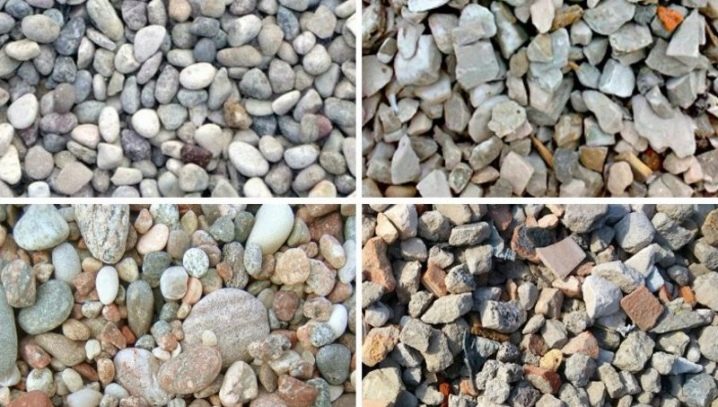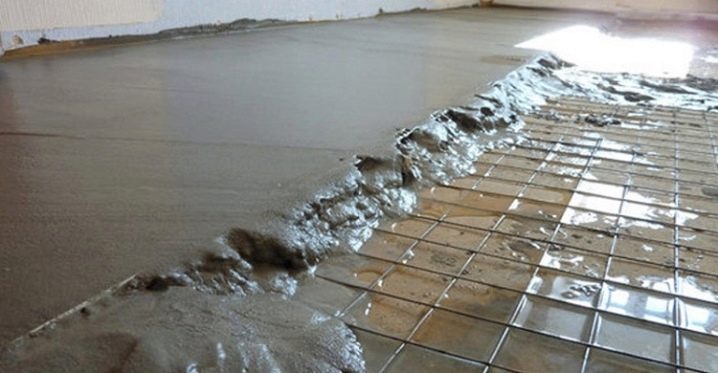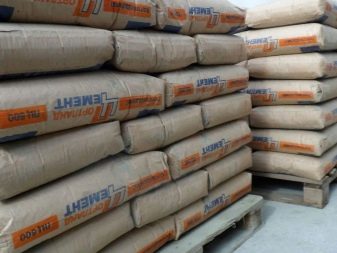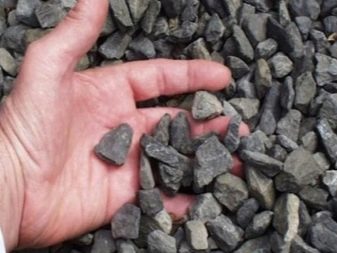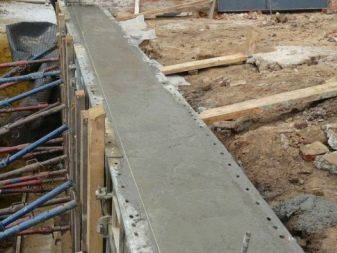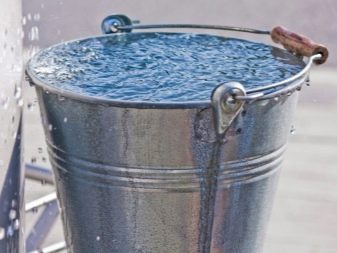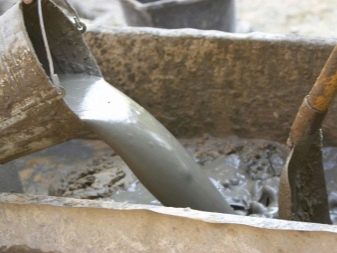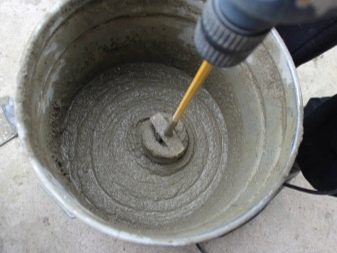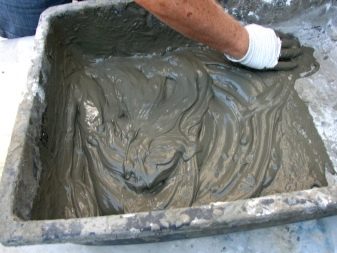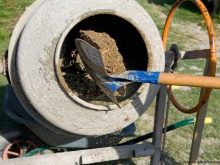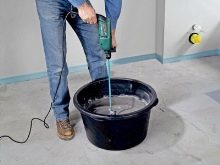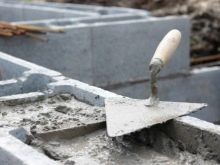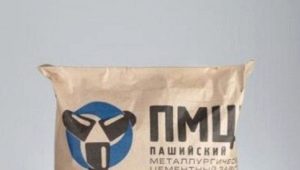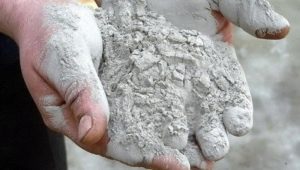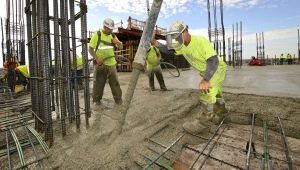The proportions of cement mortar: the ratio and consumption
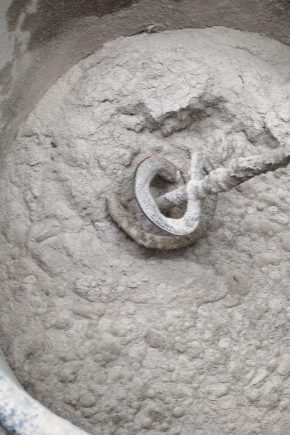
Cement mortar is one of the most common building materials for many years. It differs in its properties, components and other parameters.
This article will tell you in detail about the features of different cement mixes so that you can accurately choose the appropriate option for your case.
Types of solutions and requirements
The characteristics of the solutions differ depending on the structures for which they are used.
In accordance with the requirements of SNIP, cement compositions can be:
- Masonry. They are used to work with ground structures that operate with a minimum voltage.The composition of the masonry mixes contain lime and its derivatives. In cases with large-panel masonry, a sulfate-resistant product with the addition of slag Portland cement, Portland cement and other organic substances is necessary. The degree of mobility of the solution for brick and ceramic masonry is 7-8 cm, for rubble - 4-6 cm, for stone - 8-12 cm.
- Mounting. To fill the seams of the walls of heavy concrete used solution M100, from light - M50. The rule for determining the type of cement mortar for installation work: it must be the same brand as the concrete structure. Works should be performed at a temperature 10 C higher than the masonry one.
- Plastering. The coating should be two-layer, 5 or 9 cm thick. The solutions are cement, cement-lime, gypsum. The specific type of mixture depends on the operating conditions of the structure. Cement is used to create an outer or inner plaster layer. The mobility of the substance should be 9-14 cm.
- Protective and decorative. Such solutions are necessary for finishing porous surfaces. The mixture may include mineral and polymineral additives.The main requirement for such mixtures is frost resistance and adhesion to the surface.
Cement mix: types, brand for the foundation
To make a high-quality and effective cement solution, you need to know the optimal ratio of the proportions of all components, consistency, composition, sequence of works. For the convenience of buyers in the modern construction market there are several brands of ready-made cement, which have different purposes.
Grades of concrete and its use:
- M100 - 150 indispensable in the process of erection of non-critical structures that do not imply bearing loads. A mixture of this brand is usually chosen to create sidewalks.
- M200 - 250 designed for use as a road surface, which also does not account for excessive loads. As well as the composition is used for the preparation of reinforced concrete belts and floors.
- M300 - 350 - this is a more versatile brand of cement mixture, which is suitable for the construction of foundations, floor slabs, sidewalks, stairwells. It also creates a road surface with high loads in a cube.
- M400 - 450 - a mixture that gives one of the strongest and most durable coatings.It is used for the construction of high-strength floor slabs, supporting structures and foundations. It is also needed to create a floor covering in rooms where the floor has a heavy load.
- M500 - today it is the most durable type of cement mortar. It does not lose its characteristics even in the most severe operating conditions. Therefore, it is used in cases where the coating should be of the highest quality and reliable.
Supplements
Most often, the cement mortar contains water, cement, sand, lime, clay, sawdust, gypsum, slag. But sometimes there include various additives that differ in their properties.
These include:
- Eliminators. Such an additive provides an increase in the elasticity of cement mortar, which is perfectly used as a PVA glue for ceramics.
- Plasticizers. With their help, it will be possible to significantly increase the mobility of the composition, to reduce the degree of its consumption, to eliminate the tendency to delamination.
- Superplasticizers. This is a more modernized model of the previous additive, which allows not only to improve the properties of the solution, but also to reduce its consumption.
- Reinforcing substances. Such additives are used to provide additional strength and reliability of concrete, to avoid its deformation.
- Water insulators. Such components are indispensable for plastering and plastering work, when it is necessary to use a waterproof solution that dries quickly.
- Latex components have a wide range of applications. Using them in one solution, you can combine the properties that prevent the destruction of the material under the influence of moisture, oil and other chemical and aggressive substances. Latex additives are suitable for any type of joint solution and glue, as well as liquid glass.
- Antifreeze additives. They are irreplaceable in the conditions of the winter period. With such substances, the solution seizes much faster and does not freeze when exposed to low temperatures.
- Various pigments. If you need to change the color of the cement mortar, then this can be done with the help of special pigments.
These additives significantly improve the quality of the solution and make the process of working with it easier and faster. The main thing - to choose the right additive for a specific type of solution.
The ratio of sand and cement
If you choose a ready-made cement brand, then you need to remember some information:
- The type of mortar is determined by the load on the future foundation.
- Mark indicates the degree of strength of the solid composition in compression. The greater the number in the name of the composition, the higher its strength and cost.
- For finishing and preparatory work without a large load on the surface, you can use cement brand 100. However, for the most robust structures, you must choose brand 300-500.
- The ratio of sand, concrete and crushed stone components should be in a ratio of 1: 3: 5.
But the specific data depend on the type of material for which the solution is applied, as well as on the operating conditions, consumption and degree of load. Therefore, the ratio of cement and sand can be 1: 3 - 1: 6.
For masonry
For work with such material, the most common variant of proportions is suitable, for which it is necessary to take 1 part of cement and 3 parts of sand. Choose sand with medium particles.
In the process of preparing the mixture, you must first mix the dry ingredients until smooth, then dilute it with water. It is important that the water is clean and cold. - not higher than 15 degrees.
The resulting solution should not be excessively liquid. To check the density, tilt the container with the solution by about 40 degrees. Cement should not flow out of the container at such an inclination.
Now consider other options for the ratio of the components of the cement mixture for brickwork with the use of various additives:
- Brand 500 cement with sand - 1 part of cement to 3 parts of sand, for grade 400 - 1 to 2.5.
- Cement with lime - 1 part of cement grade 300,400 or 500 to 2.5-4 parts of sand and 1.3-2 parts of lime.
Water is added in a volume of 8/10 to 1 part of a mixture of cement and sand. For 1 part of the product brand 100, 1 / 2-7 / 10 parts of water are required.
The finished composition is perfect for lining a brick structure or a combination of its masonry.
For concrete
To determine the appropriate brand of cement for working with concrete, you should also focus on the operating conditions. The composition of the solution for such a material includes not only cement, sand and water, but also rubble, gravel and other elements. The ratio of the number of components depends on the ultimate goal.
Most often, the proportions are as follows: for 1 part of cement, 4 parts of rubble, 2 parts of sand, 1/2 of water are taken.
If you plan to add any additives to the solution in order to improve the properties of the final product, then you must use them in strict accordance with the attached instructions in the product table.
For plaster and screed
Cement mixture for such works should consist of diluted cement and sand in the ratio of 1: 5. When pouring and screed the floor is very important that the composition was as strong and resistant to external loads. The minimum strength for such a composition is 10 MPa. Therefore, the optimal grade of concrete here will be M150.
Such a material has a strength rating of 12.8 MPa, which meets the requirements. Also, when choosing the composition of cement mortar, the following parameters should be considered:
- the presence of any communications and the possibility of their concealment;
- the need to align or change the height of the surface.
For each brand of concrete used in mortars for floor screed, there are different requirements for the proportions of sand and cement:
- M100 - 1 to 3;
- M150 - 1 to 2;
- M200 - equal parts;
- M150 - 1 to 3;
- M300 - equal parts;
- M400 - 1 to 2.
For plastering of walls or other surfaces, it is necessary to prepare a mortar with a proportion of 2 to 1 components.
For foundation
The composition of the building mixture for the construction of the foundation includes not only water, sand and cement, but also crushed stone. Components must be taken in this ratio: 1 part of cement, 2 parts of crushed stone and sand. If you need to prepare a stronger structure, you can increase the amount of crushed stone added.. And to increase the elasticity of the solution should be kneaded with a high content of clay.
Treat the choice of proportions of cement for specific purposes with special care, because the wrong ratio of components can lead to a deterioration in the quality of the structure. And this should not be allowed, especially if we are talking about the foundation of a building or structures with a bearing function.
How to breed?
Cement mortar may have a different composition and consistency depending on its purpose: pouring the foundation, filling cavities, binding materials. In working condition, the mixture is always liquid, eventually the solution hardens and becomes extremely durable.
Liquid solution becomes due to water - the most important component of the mixture. It should always be added carefully, in small portions, to eliminate the risk of damage to the product.Also always follow the norms of the proportions of the components. Do the calculations in advance to find out how much of the composition will be needed per 1 m³. And in accordance with this value, calculate the amount of the finished solution.
If you do not have experience with such a building mixture, you can use special chemical fillers. They are sold on the modern market in large quantities, and help to achieve the optimum consistency of cement mortar. So you can not fear for the quality of the finished product, while not inviting professionals.
Before preparing the solution you must first pass sand and other solid dry materials through a special sieve. This will help achieve a uniform, high-quality formulation. Then you need to thoroughly mix all the components with a powerful drill with the appropriate nozzle. It is important that the fraction of the components does not exceed 2 mm.. The result should be a homogeneous mixture of gray tint without lumps and any foreign components.
Useful tips
Use the following guidelines for proper selection and operation of cement mortar:
- To increase the adhesion of the cement composition, you can add a small amount of soap or detergent to it.
- Use a container made of wood, plastic or metal to prepare the solution.
- If you need to clean the sand from any pollution, briefly soak it in water. Then you can easily clean it.
- The consistency of the finished mixture can be checked using a standard trowel: the solution should be evenly distributed throughout the instrument, and not instantly flow through it.
- Ready cement mortar must be fully used within an hour after its preparation, otherwise it will begin to thicken and become unsuitable for work. Therefore, you should not immediately make a large amount of the solution, if you are not sure that you can immediately use it.
- It is impossible to dilute already frozen solution with water, since it will lose all its properties, and its application will not give the desired result.
- When you need to prepare more than 2 cubes of cement, use for work not a drill, but a concrete mixer.
- If the solution will be used for construction with minimal loads and light weight, an increase in the amount of sand in the mixture is allowed.
- To make the product as homogeneous as possible, it must be thoroughly mixed for at least 20 minutes.
- Strictly observe the proportions of the components, as well as the manufacturer's recommendations.
Use these tips in practice, and you will not have problems with the preparation of cement mixture.
To learn how to knead cement mortar, see the following video.
